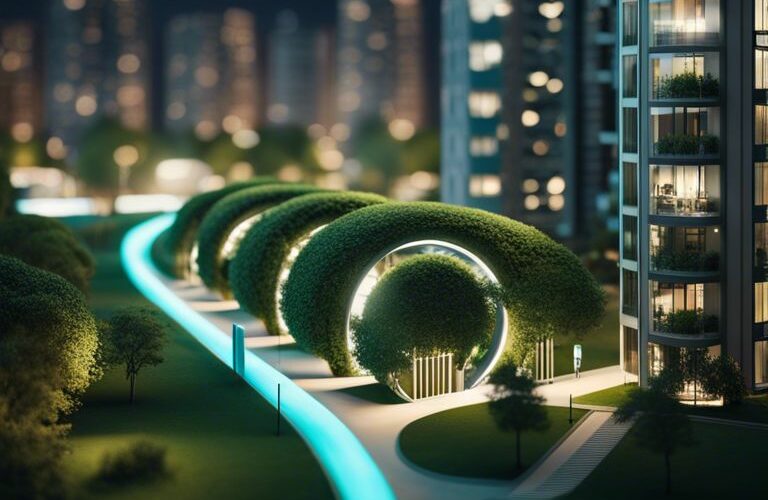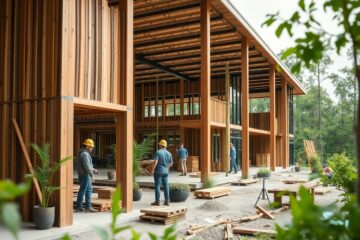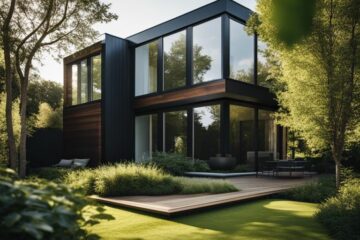Efforts towards sustainable development are imperative in today’s world, where environmental concerns have reached a critical point. Real estate developers play a significant role in shaping our cities, and their decisions can have far-reaching consequences on the environment. It is crucial to examine whether real estate developers can truly balance the pursuit of profit with ecological responsibility. This complex and pressing issue requires a thorough exploration of the challenges, opportunities, and potential solutions that lie at the intersection of economic gain and environmental stewardship.
Table of Contents
Key Takeaways:
- Real Estate Developers face the challenge of balancing profit with ecological responsibility.
- Implementation of eco-friendly practices can enhance a project’s appeal and market value.
- Collaboration with environmental experts can help developers integrate sustainable solutions into their projects.
- Adopting green building certifications can demonstrate a developer’s commitment to ecological responsibility.
- Investing in renewable energy sources can lead to long-term cost savings and environmental benefits for real estate projects.
The Fundamentals of Real Estate Development
Obviously, real estate development is a complex and multifaceted field that requires a deep understanding of various factors such as market trends, zoning regulations, construction techniques, and financial analysis. It involves the purchase of land, the planning and design of projects, obtaining approvals, securing financing, constructing buildings, and ultimately selling or leasing properties.
The Real Estate Development Process
Process: The process of real estate development typically begins with identifying a suitable piece of land for development. This is followed by conducting feasibility studies to assess the economic viability of the project and securing financing. Once the necessary approvals are obtained, the project moves into the design and construction phase. Finally, the completed property is marketed and sold or leased.
Roles and Stakeholders in Development Projects
Real: Real estate development projects involve a wide range of stakeholders including developers, investors, architects, engineers, contractors, government agencies, and local communities. Each stakeholder plays a critical role in the success of the project, from securing financing to designing and building the property to ensuring compliance with regulations and fostering community engagement.
Development: Developers are responsible for overseeing the entire development process, from the initial land acquisition to the final sale or lease of the property. They must balance the interests of various stakeholders while ensuring the project is profitable and sustainable in the long run.
The Economics of Real Estate Development
While real estate development can be a lucrative industry, it also involves complex economic considerations. Balancing profit with ecological responsibility is a crucial aspect of sustainable development in today’s world. Understanding the economics behind real estate development is essential for developers seeking to create environmentally-friendly projects.
Understanding Profit Motives in Real Estate
Motives driving real estate developers are often centered around profit. Developers aim to maximize their financial gains through property investments, construction projects, and leasing or selling properties. Profit margins play a significant role in decision-making processes, guiding developers towards choices that will yield the highest returns.
At times, profit motives may conflict with ecological responsibilities. However, there is a growing recognition that sustainable practices can align with long-term profitability. By incorporating environmental considerations into their projects, developers can enhance property values, reduce operational costs, and appeal to a more environmentally-conscious market.
Cost-Benefit Analysis of Sustainable Practices
Estate developers are increasingly turning to cost-benefit analysis to evaluate the economic viability of sustainable practices. This approach involves weighing the upfront costs of eco-friendly initiatives against the long-term benefits, such as energy savings, lower maintenance expenses, and enhanced marketability.
For instance, investing in energy-efficient appliances and materials may initially increase construction costs, but the long-term savings on utility bills can result in substantial cost reductions over time. Additionally, properties with green certifications or features often command higher resale values and attract environmentally-conscious buyers, boosting overall profits.
Principles of Ecological Responsibility in Development
Despite the push for profits in real estate development, there is a growing call for ecological responsibility in the industry. Developers are being urged to find ways to balance the pursuit of profit with sustainable practices that minimize negative impacts on the environment.
Defining Ecological Responsibility
Responsibility in real estate development means taking into account the environmental impact of projects from inception to completion. This involves considering not only the immediate effects of construction but also the long-term implications of the development on the surrounding ecosystem. It requires developers to think beyond profits and prioritize the health of the planet and its inhabitants.
Key Elements of Environmental Sustainability in Real Estate
For real estate developers to truly embody ecological responsibility, there are several key elements of environmental sustainability that must be integrated into their projects. These include minimizing waste generation, reducing energy consumption, using sustainable materials, and promoting biodiversity in the built environment.
Development that incorporates these elements not only reduces the ecological footprint of the project but also contributes to the health and well-being of the community. By prioritizing environmental sustainability, developers can create spaces that are not only profitable but also environmentally friendly and socially responsible.
Strategies for Sustainable Real Estate Development
Real estate developers today are faced with the challenge of balancing profit with ecological responsibility. As the demand for sustainable living spaces grows, developers have to adopt new strategies to meet this need. Here are some key strategies for sustainable real estate development:
Innovations in Green Construction and Design
Not only are green construction and design practices environmentally friendly, but they also offer long-term cost savings for real estate developers. Technological advancements have made it easier to incorporate sustainable materials and practices into construction projects, reducing energy consumption and waste production. From passive design strategies to the use of eco-friendly building materials, there are numerous innovative ways to minimize the environmental impact of real estate development.
Real estate developers can also explore the benefits of green certifications such as LEED or BREEAM to showcase their commitment to sustainability. These certifications not only enhance the marketability of properties but also ensure that they meet strict environmental standards. By investing in green construction and design, developers can create buildings that are not only visually appealing but also environmentally responsible.
Integrating Renewable Energy Sources and Efficiency
One of the most effective ways to reduce the carbon footprint of real estate developments is by integrating renewable energy sources and improving energy efficiency. Solar panels, wind turbines, and geothermal heat pumps are increasingly being integrated into building designs to generate clean energy onsite. By harnessing renewable energy, developers can decrease their reliance on fossil fuels and contribute to a more sustainable future.
Real estate developers can also focus on improving energy efficiency within buildings through better insulation, advanced HVAC systems, and smart technology solutions. These measures not only reduce energy costs for occupants but also decrease the overall environmental impact of the development. By prioritizing renewable energy sources and energy efficiency, developers can create buildings that are not only economically viable but also environmentally friendly.
Regulatory Frameworks and Incentives
Local and National Environmental Regulations
After acquiring the necessary land and resources for a real estate development project, developers must navigate through a complex web of regulations and laws aimed at protecting the environment. Local and national environmental regulations play a crucial role in ensuring that developers adhere to sustainable practices and minimize their impact on the ecosystem.
For real estate developers, compliance with these regulations is not just a legal requirement but also a moral obligation. Failure to follow environmental regulations can result in hefty fines, project delays, and damage to the developer’s reputation. By conducting thorough environmental impact assessments and integrating eco-friendly design measures, developers can demonstrate their commitment to responsible development.
Financial Incentives for Sustainable Development
Sustainable real estate development is not just about meeting regulatory requirements; it also presents an opportunity for developers to access financial incentives that can ease the burden of incorporating eco-friendly practices. Government entities and financial institutions offer a range of incentives such as tax breaks, grants, and low-interest loans to encourage sustainable development projects.
Financial incentives for sustainable development can help offset the initial costs of implementing green technologies and sustainable building practices. Developers who take advantage of these incentives not only reduce their environmental footprint but also improve their bottom line by lowering operational costs and increasing property values.
With the right financial support, real estate developers can make environmentally conscious decisions that benefit both their projects and the planet. By leveraging financial incentives for sustainable development, developers can lead the way in creating a more sustainable built environment for future generations.
Real-world Examples and Case Studies
Your understanding of the real estate industry’s ecological impact can be enhanced through real-world case studies. These examples shed light on whether developers can balance profit with ecological responsibility.
- Case Study 1: EcoVillage Project – A sustainable housing development in California that reduced carbon emissions by 40% through green building practices.
- Case Study 2: GreenTech Towers – A LEED-certified office building in New York that saved 30% on energy costs annually.
- Case Study 3: Waterfront Residences – A luxury condominium complex in Miami that implemented water recycling systems, saving 50% on water consumption.
Success Stories of Eco-Friendly Developments
With growing environmental concerns, success stories of eco-friendly developments offer hope for a sustainable future. The EcoVillage Project in California serves as a prime example of how innovative green strategies can lead to substantial reductions in carbon emissions and positive environmental impacts.
Similarly, the GreenTech Towers in New York showcase the financial benefits of sustainable practices, proving that profitability and eco-consciousness can go hand in hand. These success stories inspire developers to prioritize ecological responsibility in their projects.
Analysis of Failed Projects and Lessons Learned
Stories of failed eco-friendly projects underscore the importance of careful planning and implementation. It is essential for developers to learn from past mistakes to avoid wasting resources and causing environmental harm. By analyzing these failures, the industry can identify key pitfalls and implement better strategies in future developments.
Overcoming Challenges and Resistance
Barriers to Implementing Sustainable Practices
The real estate development industry faces several challenges when it comes to implementing sustainable practices. One of the main barriers is the perception that eco-friendly initiatives are costly and may reduce profitability. Developers often face resistance from investors and stakeholders who prioritize short-term financial gains over long-term sustainability.
Regulatory hurdles also pose a challenge for developers looking to incorporate green building practices. The complex maze of building codes and zoning regulations can be overwhelming, leading some developers to opt for traditional construction methods instead of exploring sustainable alternatives.
Changing Mindsets and Industry Culture
To drive meaningful change in the real estate development industry, it is crucial to shift mindsets and foster a culture of sustainability. Industry professionals need to be educated on the benefits of green building practices and be encouraged to think beyond immediate financial returns.
By promoting collaboration among developers, architects, and environmental experts, the industry can work towards establishing new norms that prioritize ecological responsibility. Investing in ongoing training and development programs can help professionals stay up-to-date on the latest sustainable technologies and practices.
Resistance: Overcoming resistance to change is crucial for the real estate industry to embrace sustainable practices. By educating stakeholders, demonstrating the long-term benefits of green building, and incentivizing eco-friendly initiatives, the industry can pave the way for a more sustainable future.
The Future of Sustainable Real Estate Development
Now more than ever, sustainable real estate development plays a crucial role in addressing environmental concerns and creating a more resilient built environment for future generations.
Emerging Trends in Ecology and Real Estate
Sustainable real estate development is witnessing a shift towards incorporating green spaces, eco-friendly materials, and energy-efficient designs. Developers are increasingly recognizing the importance of preserving natural habitats, reducing carbon footprints, and enhancing biodiversity within their projects. This trend is not just driven by consumer demand for eco-conscious living spaces but also by a growing awareness of the urgent need to combat climate change.
The integration of advanced technologies such as smart building systems, IoT sensors, and renewable energy solutions is becoming more prevalent in sustainable real estate development. These innovations not only optimize resource management and reduce operational costs but also improve the overall quality of life for occupants. As the industry continues to evolve, we can expect to see a greater emphasis on leveraging tech-driven solutions to enhance environmental performance and sustainability in real estate projects.
Predictions and the Role of Technological Advancements
To meet the increasing demand for sustainable real estate, developers are likely to embrace cutting-edge technologies such as 3D printing for construction, virtual reality for design visualization, and artificial intelligence for energy management. These tools will not only streamline the development process but also enable more precise decision-making and resource utilization. As a result, we can anticipate a rise in eco-friendly buildings that are both high-performing and cost-effective in the coming years.
Real estate developers need to stay abreast of these technological advancements and incorporate them into their sustainability strategies to remain competitive in the evolving market. Failure to adapt to these changes could not only lead to missed opportunities for innovation and efficiency but also pose significant risks in terms of environmental impact and long-term viability of real estate projects.
To wrap up
Ultimately, real estate developers have a crucial role to play in balancing profit with ecological responsibility. By adopting sustainable practices, incorporating green technologies, and prioritizing environmental impact assessments, developers can contribute to the preservation of natural resources and the reduction of carbon footprints in their projects. It is imperative for developers to embrace their social responsibility and consider the long-term effects of their actions on the environment and future generations.
In conclusion, while the real estate industry may traditionally prioritize profit margins, there is a growing recognition of the importance of integrating ecological responsibility into development practices. By aligning financial objectives with sustainable principles, developers can not only enhance their reputation and appeal to environmentally conscious consumers but also contribute to the global efforts towards a more sustainable future.
FAQ
Q: What is the concept of balancing profit with ecological responsibility in real estate development?
A: Balancing profit with ecological responsibility in real estate development means finding ways to make profitable ventures while minimizing negative impacts on the environment and promoting sustainability.
Q: Why is it important for real estate developers to consider ecological responsibility?
A: Real estate development can have significant environmental impacts, including habitat destruction, resource depletion, and increased carbon emissions. By incorporating ecological responsibility into their projects, developers can help mitigate these effects and contribute to a more sustainable future.
Q: How can real estate developers balance profit with ecological responsibility?
A: Real estate developers can balance profit with ecological responsibility by incorporating green building practices, using sustainable materials, promoting energy efficiency, preserving natural habitats, and engaging with local communities to ensure environmentally friendly designs.
Q: What are some examples of green building practices in real estate development?
A: Green building practices in real estate development include using renewable energy sources, implementing water conservation measures, utilizing recycled materials, designing energy-efficient buildings, and creating green spaces like rooftop gardens or community parks.
Q: What are the benefits of incorporating ecological responsibility into real estate development projects?
A: The benefits of incorporating ecological responsibility into real estate development projects include cost savings from energy efficiency, increased property value, positive public perception, improved occupant health and well-being, and long-term sustainability for both the environment and the community.

Our contributing author is a passionate advocate for eco-friendly living and sustainability. With a background in eco-life, they are dedicated to inspiring and empowering individuals to adopt environmentally conscious lifestyles. Through insightful articles, they share practical tips, innovative solutions, and thought-provoking perspectives to promote a greener, more sustainable world. Join them on the journey towards eco-smart living and discover how small choices can make a big impact. 🌱









